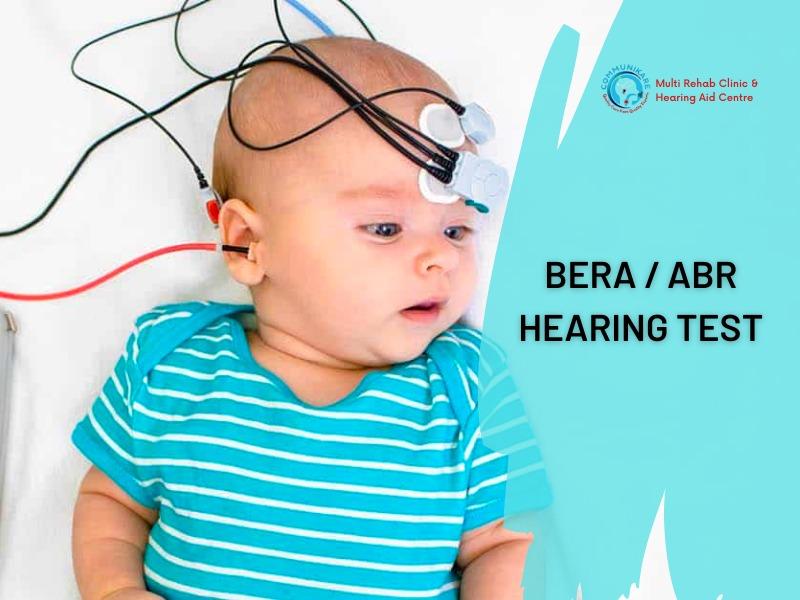BERA / ABR HEARING TEST
Admin
December 26, 2022

BERA / ABR HEARING TEST
BERA (Brainstem Evoked Response Audiometry), also known as Auditory Brainstem
Reactions, is an electro-physiological test process that measures the responses of brain waves
to a clicking sound to identify the central modality or hearing pathways of the neural
structure.
Brainstem-evoked response audiometry (BERA) is an objective hearing threshold evaluation
tool. In addition, it aids in the diagnosis of retrocochlear lesions when hearing loss or
abnormal speech development is suspected.
Brain Evoked Response Auditory (BERA) is a hearing test administered to children between
the ages of 1 and 3 years. In the meanwhile, Oto Acoustic Emission (OAE) examinations can
be performed on younger children. If the BERA test results indicate that the child’s hearing
function is within normal parameters, no more medical treatment is required. However, if
the BERA test results are deemed abnormal, the examination will proceed with the
calculation or prediction of the hearing threshold, and hearing aids must be used as soon as
feasible for rehabilitation. The BERA examination will last roughly one hour.
This approach involves the study of the electrical activities and responses of the brain to
sound and is useful for testing the hearing abilities of both children and adults
Need of BERA Test
Hearing loss in children is difficult to detect at an early age. Hearing loss can result in
communication, cognitive, social, and emotional difficulties. Therefore, it is preferable to do
hearing tests on youngsters as soon as possible.
Hearing is healthy when the auditory nerve can carry sound impulses from the ear to the
brain at a particular rate. The BERA test can reveal if nerves transmit sound impulses to the
brain and whether the rate of transmission is within normal parameters. This hearing test
can detect the child’s abnormality type (conductive or sensorineural), severity (hearing
threshold), and hearing loss kind (inner ear or other).
Additionally, BERA is utilized in otoneurologic diagnostics for evaluating the hearing
threshold. Patients with unilateral or asymmetrical hearing loss can benefit from this
(hearing nerve tumors, brain tumors, other nerve disorders, multiple sclerosis, etc.).
BERA Test Procedure
BERA can be performed without the patient’s participation. Patients need just lie down,
preferably in a relaxed state or when asleep. This examination can be performed on children
when they are awake, asleep, or under anesthesia (although rarely). During the BERA test,
electrodes will be inserted into the patient’s head and behind the ear. Upon completion of
the evaluation, the patient will hear various noises through headphones. This test analyses
variations in electrical brain activity (EEG) in response to sonic stimulation. Hearing loss is
indicated by abnormalities in the transmission of signals when sound is heard.
Auditory Brainstem Behavior (ABR / BERA) test is objective, i.e., the most valid
electrophysiological method that does not involve the baby’s participation, and is commonly
utilized for audiological diagnosis. Typically, newborns can be handled while they are
asleep. The procedure is conducted under anesthesia on infants and older children who
cannot be put to sleep naturally. ABR treatment does not harm or hurt the infant. The
hearing nerve is stimulated using small electrodes implanted on the baby’s forehead and
behind the ears and a headset linked to the ears.
The answer is recorded to determine hearing thresholds.
If healthy infants with no risk factors for hearing loss pass the screening test three times, the
ABR test is administered. In addition to the screening test, ABR evaluations should be
performed on infants who have been in the neonatal intensive care unit or who have
additional risk factors for hearing loss.
Benefits of the BERA
In BERA, electrodes are placed on the scalp and behind the ear to measure the brain’s
capacity for receiving sound waves in the form of electrical signals. A specialized headphone
can also be used to transmit clicking noises to the inner ear. Difficulty with hearing is
indicated by any impediment in signal transmission.
Benefits of the BERA (Brainstem Evoked Response Audiometry) test include early detection
of hearing impairment and identification of its causes.
This test carries minimal risk of problems, is painless, and requires no particular preparation
for the BERA examination.



Categories

We Care for Your communication,
Quality Care from Quality Experts.
Quick Links
Subscribe Our Newsletter
You’ll receive regular updates on our special offers, and other exciting news.
www.communikare.in